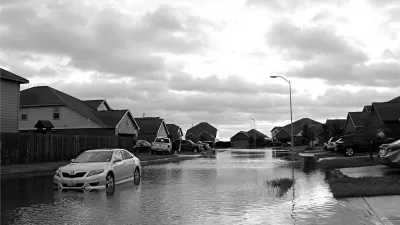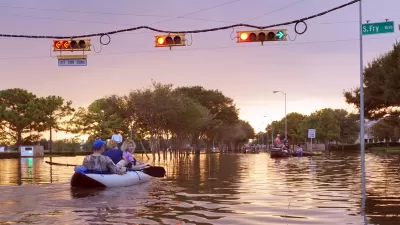Houston's most recent natural disaster is only the latest example of how a program created to help homeowners has been a greater benefit to the industries that profit from them.

An exhaustive piece by the Houston Chronicle that is both study of, and investigation into, the National Flood Insurance Program, begins with the statement that it is a failure.
“The impact of Congress' failure is undisputed. The National Flood Insurance Program was supposed to discourage development in flood-prone areas, but new development has spread across flood plains, including thousands of homes in the Houston area that flooded during Hurricane Harvey.”
It’s hard to disagree, when an earlier installment of the Chronicle’s enterprise series noted that a development for 900 new houses in an area that flooded during Harvey nearly slipped through the City Council unopposed only two months after the hurricane.
The National Flood Insurance Program has existed since 1968, but even as it was being designed lawmakers recognized the risk.
“In 1966, a task force commissioned by President Lyndon B. Johnson recommended that the government offer below-market rates to entice property owners to enroll in the program. But it warned that such an approach presented dangers if low insurance costs were allowed to become incentives for building in flood-prone area.”
Those below-market premiums have meant that the program cannot pay for itself. It has required taxpayer bailouts 16 times in 25 years, according to the Chronicle, and is $20 billion in debt—and that’s before it pays out another $10 billion in claims from Hurricane Harvey.
Legislation that would raise insurance premiums has generally been thwarted, often by lawmakers whose constituents benefit from booming real estate markets, or often who have received significant donations from industries related to building and real estate; last year the National Association of Realtors spent, just on lobbying Congress, four times more money then Exxon-Mobile.
Meanwhile, by financing rebuilding, repeated claims on the same homes under the flood insurance program have at times added up to many times the value of the property.
And ultimately, low premiums on flood insurance are a detriment to homeowners.
“Those subsidies have helped lure generations of homeowners into properties that trap them in a cycle of building, flooding and rebuilding. Henry Thompson and his wife, for example, bought their home not far from Cypress Creek three years ago. They knew the neighborhood northwest of Houston flooded, but the cost of flood insurance was so low — about $400 a year — they bought anyway.
Then Harvey swept 2 feet of water under their threshold, forcing them to live on the second floor for the past three months with a microwave, an electric skillet and two young children. They want to sell, but can't imagine they'll find a buyer, leaving them with little choice but to cash the insurance check, rebuild and wait for the waters to rise again.”
FULL STORY: Build, flood, rebuild: flood insurance’s expensive cycle

Maui's Vacation Rental Debate Turns Ugly
Verbal attacks, misinformation campaigns and fistfights plague a high-stakes debate to convert thousands of vacation rentals into long-term housing.

Planetizen Federal Action Tracker
A weekly monitor of how Trump’s orders and actions are impacting planners and planning in America.

San Francisco Suspends Traffic Calming Amidst Record Deaths
Citing “a challenging fiscal landscape,” the city will cease the program on the heels of 42 traffic deaths, including 24 pedestrians.

Adaptive Reuse Will Create Housing in a Suburban Texas Strip Mall
A developer is reimagining a strip mall property as a mixed-use complex with housing and retail.

Study: Anti-Homelessness Laws Don’t Work
Research shows that punitive measures that criminalized unhoused people don’t help reduce homelessness.

In U.S., Urban Gondolas Face Uphill Battle
Cities in Latin America and Europe have embraced aerial transitways — AKA gondolas — as sustainable, convenient urban transport, especially in tricky geographies. American cities have yet to catch up.
Urban Design for Planners 1: Software Tools
This six-course series explores essential urban design concepts using open source software and equips planners with the tools they need to participate fully in the urban design process.
Planning for Universal Design
Learn the tools for implementing Universal Design in planning regulations.
Heyer Gruel & Associates PA
JM Goldson LLC
Custer County Colorado
City of Camden Redevelopment Agency
City of Astoria
Transportation Research & Education Center (TREC) at Portland State University
Jefferson Parish Government
Camden Redevelopment Agency
City of Claremont





























